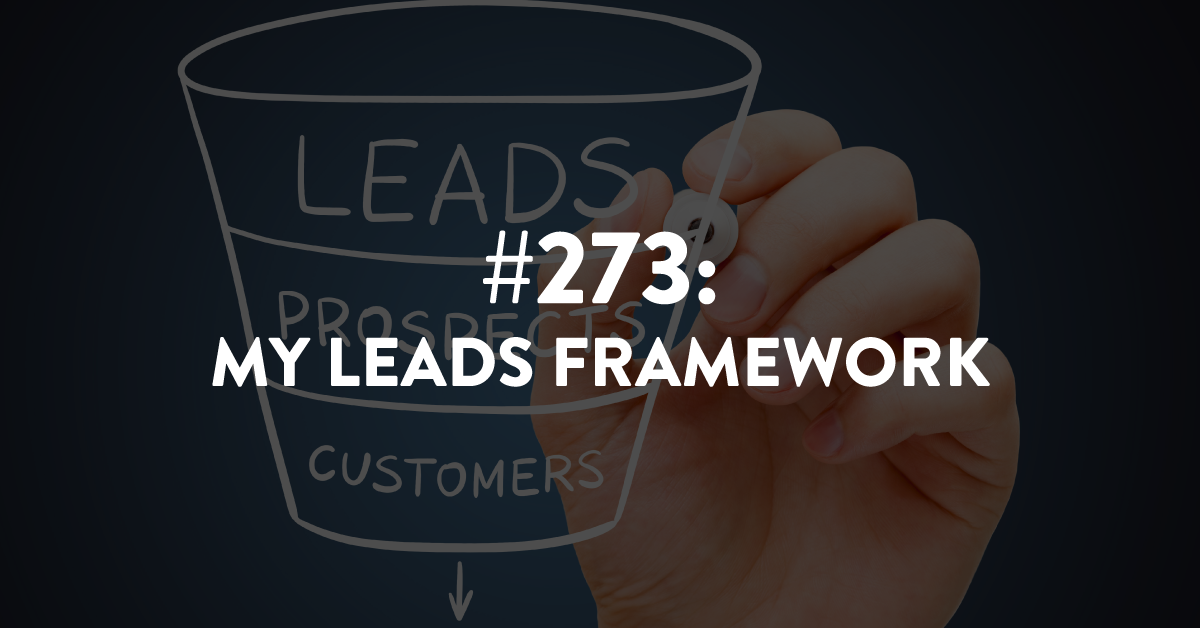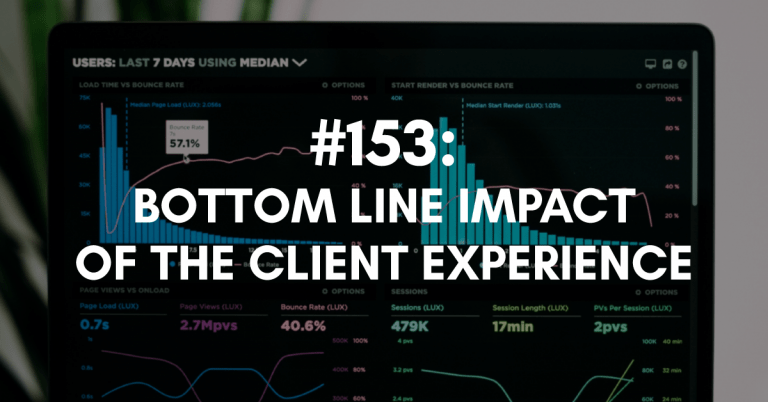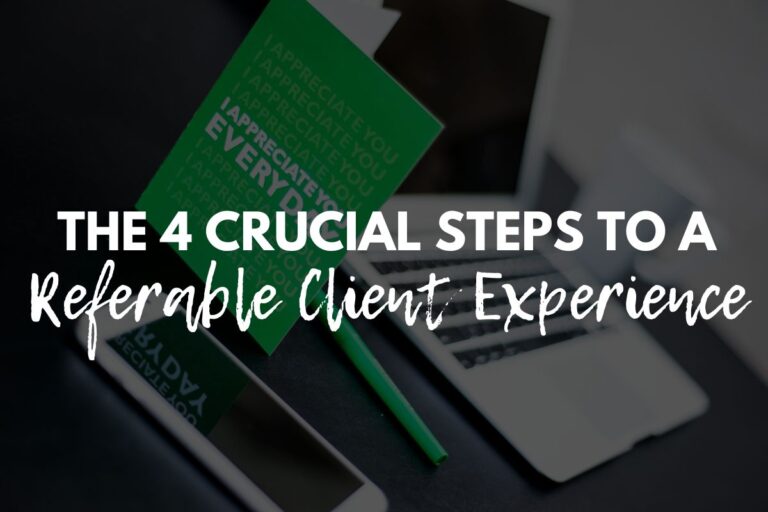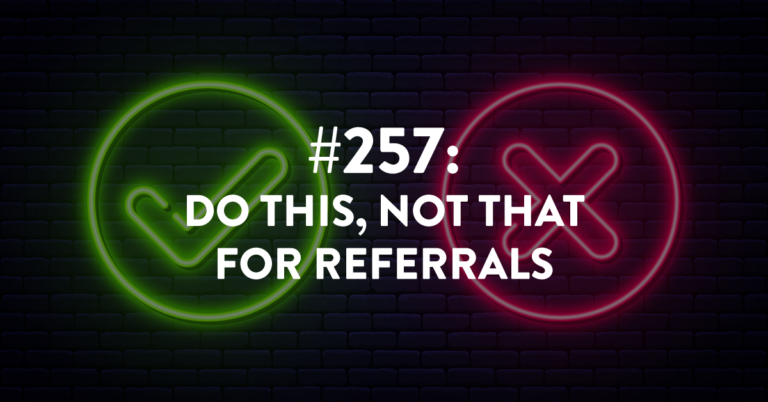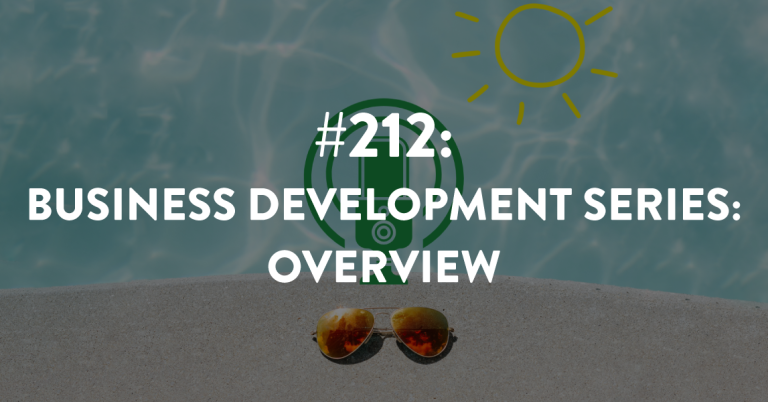Ep #273: My Leads Framework
Do you know how to avoid the rocking horse syndrome inside your business? By having the right leads framework.
Every day as a business owner you make a multitude of decisions. From mundane ones to important ones. Little ones to big ones. Some decisions are inconsequently to the growth of your company. But the decisions you make about sales is in a category all by itself.
In this episode, I explain the three categories that encompass all sales activities and how using this framework helps me make decisions in my own business. This helps avoid the “rocking horse syndrome” of feeling busy but not making progress. Let me break this leads framework down for you.
Every sales activity you do – including referrals – falls into one of these three parts of the framework. And you guys know how much I love my frameworks. Listen in to how this concept was a game changer for me and has become a guiding force in how I make decisions within my company.
Links Mentioned During the Episode:
Submit your application to join us inside Building a Referable Business™ coaching program and attend our live training later this month.
Next Episode:
Next episode is #274, where I will give you a look behind the curtain on how we prep for success inside BRB.
Download The Full Episode Transcript
Read the Transcript Below:
Stacey Brown Randall: Do you know how to avoid the rocking horse syndrome inside your business? By having the right frameworks. We’re gonna talk about a leads framework today.
Hey there, and welcome to episode 273 of the Roadmap to Referrals podcast, a show about helping you build a referrable business. I’m your host, Stacey Brown Randall.
My journey from a business failure to a successful business now 10 years in. I know generating referrals naturally and consistently has made all the difference. Working with clients around the world, we leverage the science of referrals, protect relationships above all else, and help you build a referrable business.
Every day as a business owner, you make a multitude of decisions. From mundane ones to really important ones. From little decisions to really big decisions. Some decisions, like which printer paper to order, are inconsequential to the growth of your company. But the decisions about how you’re gonna make sales, i.e. bring in new clients, well, that’s in a category all by itself.
So in this episode, I want to share how I make decisions on what I deploy within my sales strategy, specifically the activities that I choose to do and how I judge if they work or not.
I was first introduced to this concept from Ben from Cash Flow Podcasting. His company is a podcast production and editing firm.
He shared that all sales activity falls into one of three categories, lead gen or lead generation, but I’m gonna refer to it as lead gen. Lead gen, lead nurture, lead conversion.
Mind blown. It was a light bulb moment for me. I just never thought about it in that way. It gave me a framework to figure out how to decide how much money I spent in one area versus another, and how I judged the success of something, or even whether or not I needed something.
And if you’re a long-time listener of this podcast, you guys know how I love my frameworks. This leads framework was a game changer and has become a guiding force in how I make decisions within my company.
It’s also helped me avoid what I call the rocking horse syndrome. You know it, moving really, really fast or feeling like you’re moving really, really fast or working really hard, but in reality, you’re actually going nowhere.
Come on, rocking horse syndrome, you know you instantly pictured it, didn’t you? I know I did, and I got that little gem from Justin Welsh.
Let me break this leads framework down for you. Every sales activity you do, including referrals, falls into one of these three parts of the framework – either lead gen, lead nurture, lead conversion.
So every sales activity you do is gonna be categorized into one of those three, call ‘em parts, call ‘em categories, call ‘em buckets, whatever you wanna call them, right? They’re gonna fit into one of them. And there may be some overlap as well, and we’ll talk through that as we go.
But let me define each of these first, and then I’ll give you some examples before I kind of dig into what it looks like inside my business and how I apply this framework personally.
Okay, so let’s define.
Lead gen, that’s generating new leads or prospects. Now in this case, I really think that you can use leads and prospects interchangeably. I know I do inside my business.
I know there are some people that would say a lead leads into a prospect, which then leads into a paying client. Some people would say you can use leads or prospects interchangeably. For this point, I mean I think it’s what I do inside my business. I use leads and prospects interchangeably.
I know there are some people who teach sales training that would say it’s more nuanced than that. So you can use and apply your definitions. But just know in this case, we’re using leads like they’re prospects.
These are people who have not decided to work with you. They are in the buyer’s journey. We’re trying to get them actually into the buyer’s journey. Let me clarify. We’re trying to get them into the buyer’s journey, somebody who has potential, who may want to consider working with you or hiring you.
Okay, so lead gen, generating new leads, prospects.
Lead nurture, that’s the mechanisms that you have in place that nurture someone who isn’t ready to buy right away.
And then lead conversion, that is moving a prospect to becoming a paying client and saying, yes, I want to work with you. Where do I sign? Where’s the dotted line, right?
So, lead gen is generating new leads or prospects. It’s the activities you do that get people to say, hey, wait, you exist, right?
Then there’s lead nurture. Those are the mechanisms that nurture someone who maybe isn’t ready to buy right away, but you’re gonna nurture them over time. That’s lead nurture.
And so, here’s how I want you to think about the difference. But when I say lead nurture, it’s like nurturing somebody who’s not ready to buy right away.
Everybody has a different timetable in which they buy on, right, or buy in. So, some people may find you and buy within the first 24 hours. Some people may find you and not buy you, right, not hire you for 14 months.
Lead nurture is what happens from the point that they learn about you to the point they decide to give you money, or they decide not to give you money and they don’t become a client, right?
So, thinking about lead nurture, we also have to think about it in different timetables. So, it’s the things that you do that nurture someone who isn’t ready to buy. And I typically think about that from right away, right? Someone falls into my world, if they like read my book and they’re like, oh my gosh, I gotta hire Stacey, I’m not really nurturing them, let’s be honest, in that timeframe, right?
But we got lead gen, lead nurture, and lead conversion. All right, so let me just dig in and give you some examples as this, so you guys can kind of really start picturing it in your mind’s eye.
Hey there, pardon the interruption. Coming up later this month, I’ll be sharing exactly how the magic works inside my Building a Referable Business Coaching Program. I’ll show you how I work with clients to help them double, triple, or quadruple their referrals in as little as 90 days. Go to staceybrownrandall.com/referable to submit your application, and I’ll share with you all the details of this live, private training.
The link again is staceybrownrandall.com/referable. Now back to the episode.
Okay, so let me give you some examples of lead gen. I’m just gonna give you one example in each of these three categories.
So, an example of lead generation, lead gen would be referrals, right? It would be somebody who’s a referral source that refers a potential client to you.
An example of lead nurture would be like maybe your weekly email. If you send a weekly email out to people who are on your email list, that would be like a lead nurture.
And an example of lead conversion could be like a discovery call. You get on the call with somebody and help them decide if you’re the right person to work with them and help them get to the point of saying yes or no.
Here’s the thing. Nurture and conversion, they don’t really matter much without generation, but you absolutely have to have all three to be successful.
I bring this up because a lot of times I see people who have lead nurture and lead conversion in their business, but they’re missing lead generation. They’re like actually missing the mechanism that gets people into their funnel, into their prospecting funnel, into their buyer’s journey.
But they have this great buyer’s journey and this nurture process, and this conversion process built out, but they’re actually, they don’t get anybody in.
Now on the flip side of that, it doesn’t do you a lot of good if you have great mechanisms to get people into your world and then you do nothing with them and you ghost them, right?
So, you need all three. Absolutely you need all three. But if you don’t have anybody coming in through lead generation, your nurture and your conversion will matter less.
So, when you’re thinking about how to maybe deploy or execute or implement on some of the stuff we’re talking about in your business, after you listen to this episode, please keep that in mind.
You may know, hey, I need some work on my lead nurture, my lead conversion, but we better start with lead generation first so that I actually have people coming into the process so that I actually have people to nurture and to convert.
So, one of my favorite parts of this framework is how it helps me when I’m making financial decisions. Because let’s be honest, most everything you’re gonna do from a sales activity perspective is going to cost you some dollars. It’s gonna cost you some amount of money.
Some decisions are gonna cost you a whole lot of money and some are gonna cost you like a little bit of money, right? But I like how I can have this framework that helps me make financial decisions.
So first I figure out which bucket the activity will fall into, like hey, is this lead gen, lead nurture, or lead conversion? And then I make sure that that activity, once I’ve put it into the correct bucket, I make sure that that activity meets the priorities of that bucket accordingly.
So how I judge if something is working, if it’s lead gen or lead nurture or lead conversion, how I judge those are based on these kind of priorities.
Number one is, let’s be honest, how much money does it cost in relationship to what it’ll actually do, right? So how much is it gonna cost me to do this activity? And that could be a software I have to purchase, that could be a networking group I need to join. Whatever it is, how much is it gonna cost me? And not just like initial cost but ongoing cost as well, in relation to actually what I’m expecting it to do.
The next priority is, how much of my effort will it take? The hardest thing about working with business owners, as a business owner myself, is that recognizing that a lot of people want things to happen instantly. Like a lot of people are like, where’s the easy button, let me push this button and let the leads roll in. And it just, it doesn’t work like that.
I read this article once where people were talking about new business owners or business owners who haven’t quite grown into being a business owner have this expectation that they’ll buy this training, buy this software, do this thing, execute on this activity or exercise and all of a sudden, all their problems will be solved and everything they want fixed will fix.
Versus a well-established business owner decides to buy the training or do the software or whatever because ultimately they’re looking for increments of iteration, of walking away with one piece that’ll make their life better. It’s a big mindset shift when you think about that.
So, I also do pay attention to the effort something’s going to take but I recognize everything that I do takes effort. Some just take more than others and I wanna make sure I am balancing that out with how much it’s gonna cost in relation to what I’m expecting it to do.
Which is why the second priority is, how much of my effort will it take? It doesn’t mean I don’t want things that don’t take effort. I just wanna be aware of that because the worst thing you can do is decide to do a sales activity and then slack off and not put in the effort you’re supposed to put in and then blame the sales activity. That’s not the sales activity’s fault that you didn’t do what you’re supposed to. So, I need to know that upfront.
The third priority that I look at is the results that I expect and how easy or hard it is to judge if those results are being met. The truth is some things I do, there’s a number that goes along with it.
How many referrals did I receive in August? How many of those referrals converted to paying clients. Some things I do, there’s a metric, there’s a number and I clearly know if it’s working or not. But other things, it’s not as clear, right? And in other ways, it’s not as clear. So, I gotta make sure I understand the results that I’m expecting, how easy or hard will it be for me to judge if I’m having those results?
Some things I do and it’s more like, it’s like building of the brand, right? Building of that branding, building of that reputation, and it takes time, sometimes years to get there and you have to understand that it’s an investment, right? That the ultimate goal is just you’re wanting to pay off.
And then of course the last one is, is how long till I’ll see results? I don’t expect any easy buttons in my business. I don’t expect anything I do today to produce thousands or hundreds of thousands of dollars tomorrow.
I’ve been doing this for 10 years and so I have been around the block, right? Like I know this is not my first rodeo. I know what this looks like. But I still need to have an idea as like, hey, am I expecting to see results in six months? Or am I expecting to see results in a year? Or should I expect to see results in 60 days?
But those are the priorities of how I judge if something is working, and what it looks like based on the bucket that it’s in. So those four priorities look different if I’m applying them to lead gen versus applying them to lead conversion. They just, they look different. It’s the same priorities, but the mechanisms, right? The metrics that come out of it look different. You’ve got to figure out what that looks like for you and your business.
And it’s when I have these things in place. It’s when I know my buckets – lead gen, lead nurture, lead conversion, and then how I judge how something should be performing within those four priorities within each of those buckets that I then know I’m not a rocking horse.
I’m not just rocking really hard, really fast and ultimately looking around and realizing I didn’t go anywhere. But man, I worked up a sweat. But I didn’t actually move an inch, right? And this is why this part, this framework is so important for me.
So, here’s the thing. Let’s say that I don’t always know because it’s true. That I don’t always know with a definitive answer in the beginning how a new activity will stack up to the priorities that I have set. Which means I’m really comfortable and okay with testing and experimenting and then waiting to see what will happen.
I wasn’t like this in my first year of business. Let me be honest with you. This is something, this is a muscle that I’ve stretched, and this is a muscle that I have strengthened over a decade of being in business.
Which means sometimes I’m taking a leap of faith. Sometimes I’m looking at something and I’m saying to myself, wow, that is a hefty price tag of something that I want to do in my business, that I want to understand how to do in my business. I’ve done my research. I believe I know how it will work. I understand what effort I’m gonna have to put into it. I understand what the metrics will be coming out on the back end. But I don’t know definitively that’s exactly what I will receive. So, it’s a leap of faith.
And for me, as long as that leap of faith is based on facts, which I recognize is like the exact opposite of leap of faith. But I’m not talking about this like a Christian leap of faith. I’m talking about a leap of faith, but as long as it’s based on facts of what I expect to happen.
So, I really look at things and decide what is this gonna do? What should it look like? What will I wanna look like? How will I know when I’ve been successful? That whole part is part of the framework.
Yes, it’s these three buckets, these three categories, lead gen, lead nurture, lead conversion. But it’s also those four priorities that has the metrics and the expectations and the objectives built within each of those four buckets that I can then measure and test and see if the activity I wanna do is actually giving me ultimately what I expect.
So let me just kind of give you an idea of a little bit about how this works in my business. So, let’s first start with lead generation. So, when I look at lead generation in my business, I know there’s a lot of things that actually can fall in different categories. I know that there are people who will say something I’m gonna say is lead conversion, they use it as lead generation.
So you can apply these in different ways. I am just telling you how it works in my business. I also recognize some of the things I’m gonna say, I can tell you, yep, that’s lead generation, but I also know there are people in my world who actually use it as lead nurture as well. These aren’t like concrete structures that you can’t ever break out of the box once you’re in the box, is how I want you to think about it.
So, here’s the things that I look at from my business perspective, from a lead generation perspective. Number one, of course, it’s referrals. I practice what I preach, right? So referrals is a big part, and it’s, I know the metrics, I know how much effort it takes, I know exactly what I expect to accomplish when I’m doing it.
When I pay attention to referrals in my business, I know all those framework pieces of exactly what I want to come out of that opportunity with referrals, and I know how much it’s gonna cost me and what I’m gonna do, and the time and energy I’m gonna put into it.
So, referrals is one part of my lead generation. So is my book. I have less control over my book doing its thing as a lead generation, but I know the longer my book has been out, so this happened right after my book came out, and then it’s happening more and more the longer my book is out, that it’s just picking up more and more SEO traffic, particularly on Amazon.
So, there are people who will go to Amazon, and they’ll be like, give me a book on referrals, and Amazon likes me now, so it pops up, and it’s more likely to pop up with some of maybe the other more well-known referral experts out there who teach, of course, the complete opposite way that I teach.
So that SEO piece is working. It’s why the title of the book was really important. It’s why “without asking” had to be in the title because we wanted to make sure people understood that I’m totally different from 99.9% of all the people out there teaching referrals.
But my book, Generating Business Referrals Without Asking, that’s a big piece of that.
Another lead generation tactic that I do, or activity that I do, is podcast guesting. I will be a guest on other people’s podcasts. Some of you listening to my podcast right now came to me because you heard me on another podcast you listened to, and you were like, ooh, she’s intriguing, and now I’m gonna listen to her podcast, right?
So, when I am a guest on other people’s podcasts, that is actually a lead generation mechanism for me. That doesn’t mean the things I’m saying to you, you need to start doing, because they may not fit.
My business has no borders. It’s an international business, so being on podcasts that can reach people anywhere at any time is actually really, really important for my business.
That’s not to say that a local CPA can’t be on podcast, that wouldn’t grow some client base for them. But that’s how I look at it from my perspective.
And then the fourth thing is actually some targeted LinkedIn efforts that I have done in the past and are considering doing again in the future. Some of these things I lean into, pull back, because I’m always testing.
So, this is not everything that I do that generates prospects or leads into my business, but it’s like the four that I pay attention to. And like I mentioned to you, two of them, technically three of them, excuse me, three of them I feel like I have a really good control over in terms of my effort – the referrals, the podcast guesting, and then of course the targeted LinkedIn efforts. The book, not as much, right?
The other thing is though is that I don’t know who’s gonna say yes to having me on their podcast, so I don’t control everything. I gotta put in the effort, I gotta put in the work, and I gotta keep making sure that it’s working for me.
So that’s lead generation for my business. Let’s look at lead nurture for my business.
So, lead nurture for me is hey, number one, this podcast, you listening to this right now. There’s a lot of people who will be referred to me or will read my book or will hear me on another podcast or will see some kind of targeted LinkedIn outreach that maybe I’ve done and then they will find their way to this podcast.
And they tell me that. Like hey, how did you hear about me? Well, I’ve been listening to your podcast ever since I heard you on XYZ’s podcast, right? So that’s how I know that that’s how that works. So, this podcast, I don’t actually use it with the expectation that it’s gonna generate me a ton of new clients.
It does, but that’s not what I’m expecting from it. I just love it when it happens. What I’m expecting from it is this podcast is to nurture you, to get you to the place to understand what I believe, my philosophy, how it works, giving you tips, having you understand and hearing from other people who’ve had success working with me, all of that to nurture you to the place to make the decision of yes, I wanna work with Stacey or no, I don’t. That’s why we use the podcast.
The book also is its own nurture. I mean, I would say that that book really does fall in those two categories more than really anything else. There are people who land in, you know, they hear about me on another podcast, they start listening to this podcast, they hear me talk about my book and they go out and buy it and the book becomes the next step in their nurture process.
Like I said, it’s not like once you’re in one category, you can’t be in the others. You probably just shouldn’t have everything from one category in all the other categories.
So, another thing that I do from a nurture is some of my free training. Like we just did a three-part summer school, summer school of referrals in July. I did it, it was a free training. We did three classes, Referrals 101, all the way to Referrals 301 that people could participate in with me and I did it for free and people could sign up.
Now once, of course, the classes were over and the replay time had ended, we did repackage that and actually provide it for like a low-dollar cost option for people who missed it.
And then of course another nurture thing that I do is the weekly emails. When you download something for me, when you take my quiz or you participate in a training, you’re gonna get on the email list and I’m gonna try to email you every single week.
I’m not perfect at it, I’ll be honest, but every single Tuesday or Wednesday, that’s the goal is for every Wednesday for you to receive an email from me that’s helping you on this journey of referrals and understanding what you can and should be doing. And so those emails come out on a weekly basis and so that’s part of my nurture strategy.
And then of course I would also say some of the things that we do on social media. And some of the things that we do from a social media perspective, and I don’t mean like the everyday posting type stuff we do. I mean I do think the social media that we post, whether it’s on LinkedIn or Instagram, I do feel like that has a little bit of a lead generation, lead nurture, but I think that stuff is so impossible to track that I don’t look at it like that.
I look at it as a must-have evil, that’s not fair. That’s actually how I look at it sometimes. So, I am posting on our social media platforms, but when I talk about lead nurture in this case and I’m talking about social media, yes it technically can include the social media postings we do on a weekly, or excuse me, on an almost daily basis, but I’m actually thinking about the concentrated things I do on social media.
Like back in April, we did 30 Ways to Take Control of your Referrals. And every day on social media we gave another tip of how to take control of your referrals and then at the end you could download all 30 ways in this really cool infographic that you could have as a download. So that’s what I mean in some ways from a lead nurture perspective.
And then we have lead conversion. And so, within lead conversion for me it would be like when people are interested in joining my coaching program, Building a Referable Business, I’ll get on the phone with them and do, we call it a referral audit. I’ll get on the phone with them, they’ll answer some questions, we’ll get on a call, we’ll talk through what is their reality, what do they want to accomplish, and if I think BRB can do that and then how it works. And looking at it from that perspective.
Usually, to get on an audit call they’ve already completed an application, but I know that it helps some people before they make the decision to join a year-long coaching program is to have a conversation with a person who’s gonna be teaching them and who’s gonna be working with them for the next year.
So, in lead conversion those audit calls that I do, or some people call them discovery calls, I happen to call them a referral audit call.
But it could also be any of the follow-up sequences that I do via email after something. Like if you complete a BRB application into the coaching program, there’s like a sequence of emails. Some are automated and some I’m doing because the system tells me, hey, it’s time to do this. And so the outreach that I’m doing also helps convert people into clients.
It can be any of the sales pages that are up on my website where you learn about what a training of mine or one of my signature online programs is gonna provide to you and you read testimonials and you read about how it works and then that sales page as you’re reading through everything that’s included and from that perspective that can be a conversion piece as well.
And then of course I also think that any of the testimonial type episodes or testimonial type posts that we do help convert people too.
And this doesn’t mean every single thing that I do in my business I look at it and I’m like, which bucket does it fall into? And there’s like a rigid structure that I follow, and everything’s written down and every framework’s understood. But the big things where I make my investments, those things are the things I’ve got in categories and I know what my priorities, what the expectation is of how they’ll meet my top four priorities.
But that doesn’t mean there’s not a lot of other things that I do that I’m a little bit more like Lucy Goose on, like hey, let’s just try this out and see what happens or this just makes good business sense, we’re gonna do it, not necessarily because I’m expecting exactly how it will bring a new client into my world.
So, the point here isn’t to only have one path, but multiple paths. But you have to understand what each one does so that you can set the appropriate expectations.
I just walked through a couple of examples. I gave you four examples in each of these three categories of what it looks like inside my business. It’s not an exhaustive list, but it’s the big ones that I pay attention to.
Sometimes I think it helps you understand what to do in your business when you see how somebody else is doing it inside theirs.
And so that’s why I wanted to spend this episode talking about this leads framework that I use with these three categories of lead gen, lead nurture, lead convert, and then the four priorities or metrics or expectations that I set that I can see what’s working and what’s not.
But the point is that you just have, hey, you come into my business this one way, and then I nurture you this one way, and then I convert you this one way. I think we all would love to have that. That’s not how it works. Business is a little bit messier than that.
And so having different ways, trying to meet your prospects, your next potential client where they are is important. You don’t need to meet everybody where they are. You’re not perfect for everybody, but you need to be able to meet your ideal client where they are and what that looks like.
Now I also know that some of the things that I do from a lead generation to a lead nurture to a lead conversion, some of the stuff I do, but I don’t have to spend a ton of time and energy onto it because referrals is the biggest piece of the pie of how I bring in clients. But it’s not the only piece of the pie, but it is the biggest.
So, when I look at, let’s say, and you guys have heard me talk about this before on the podcast if you’re a long-time listener, when I talk about the people who are in my coaching program, when I look at their names, I instantly know exactly where they all came from. And I know always more than 50% of them have come by referral to me.
But that doesn’t mean some of them don’t come through other mechanisms. And it’s recognizing that and acknowledging that. And then it always tells me, well, you know, this referral thing, it works.
Of course it works. I built an entire business around it and have so many satisfied clients, but it also works for me as well. And then it’s doing it over and over and over again, every year after year.
So again, the point isn’t to have only one path, it’s to have multiple paths, but the multiple paths are working the way you want them to work, and you’re tracking it the way you need to track them, and you’re seeing the results you’re ultimately looking forward to seeing.
So, this may be one of those episodes you need to come back to. This may be one of those episodes you need to listen to more than once. You can always find this episode on the show notes page, which is staceybrownrandall.com/273. That’s because this is episode 273.
So, you can always come back, maybe put this on a must listen to again list of yours, and just come back and listen to it. Maybe you need to listen to it twice, and then come back to it whenever you need it. As you’re thinking through your leads framework within your business, and the processes, the procedures, the strategies, the tactics, the mechanisms you have in place to make your business successful.
Coming up next week is episode 274, and I’m gonna give you a look behind the curtain on how we prep for success inside BRB. That’s Building a Referable Business, the coaching program.
Until then, you know what to do, my friend. Take control of your referrals and build a referable business. Bye for now.

